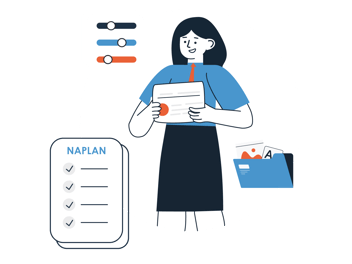
Artificial Intelligence has been a hot topic within the education industry for a while now, especially within the past 18 months, as the technology readily available to most people has skyrocketed with its capabilities.
With AI technology now encroaching into schools, it is important to dive into how this is affecting teachers and students, and their learning. With this in mind, this month’s blog takes a look at how schools are approaching AI in their classrooms, how this is affecting teachers and students, and how the Australian Government is planning on controlling this everchanging subject.
Understanding AI in Education
According to the Department of Education Queensland, Generative Artificial Intelligence (GAI) tools can contribute towards delivering future-focused learning practices that connect students and teachers. The Department reiterates that teachers remain instrumental in leading learning.
The Department of Education states that GAI tools provide the following opportunities to teachers:
- Creating and customising content
- Assisting with administrative tasks
- Designing formative assessment activities
- Analysing data efficiently
- Checking for understanding
- Creating resources to support differentiation
- Providing feedback
Alongside this, the following items are listed as opportunities for student learning:
- Personalising learning based on individual needs
- Improving accessibility
- Engaging learners
- Idea generation
- Checking for understanding
- Providing feedback
In late 2023, the Australian Framework for GAI in Schools was released. This framework aims to guide understanding, using, and responding to GAI in Australian school-based education. The framework focuses on the following six categories:
- Teaching & Learning: tools to support and enhance teaching and learning.
- Human & Social Wellbeing: tools to benefit all members of the school community.
- Transparency: school communities understand how GAI tools work, how they can be used, and when and how these tools are impacting them.
- Fairness: tools are used in ways that are accessible, fair, and respectful.
- Accountability: tools are used in ways that are open to challenge and retain human agency and accountability for decisions.
- Privacy, Security & Safety: students and others using these tools have their privacy and data protected.
With a long list of opportunities and guidelines for schools, it is important to look at how teachers themselves feel about introducing AI into the classroom.
Impact on Teachers
Australian educators are currently in the midst of a tech revolution as AI continues to rapidly advance and make its way into their classrooms. It is important to look at how AI is affecting the already very busy jobs our educators have.
Atomi, a teaching and learning platform, has recently released a Tech in Schools Report that was produced with the information provided by over 250 Australian educators.
The study shows that 60% of the educators surveyed believe that the use of AI in education will drastically change teaching methodologies, while 85% said that AI could never replace the need for human teachers.
While it is clear that there is some hesitancy around the use of AI in the classroom, an overwhelming 74% of educators believe that the technology enhances the learning experience for their students, however, only 29% of them think their school provides enough training for technology tools.
With the use of AI in the classroom currently sitting in between a rock and a hard place, it is important to also look at the impact this has on students.
Impact on Students
With the introduction of ChatGPT in late 2022, the use of the generative AI tool saw a drastic increase towards academic misconduct with the ability to produce essays, thousands of words in length, in a matter of seconds.
According to The Educator, there are increasing concerns that AI tools are writing student essays and this going unchecked would lead to learning gaps in students, causing a ripple effect on their knowledge and skills. Alongside this, the Tech in Schools Report mentioned previously shows that 60% of educators are concerned about the ethical implications of using AI in the classroom. So what is being done to prevent the unethical use of AI to ensure students do not fall into learning gaps?
In 2024, educators are quickly adapting to the capabilities of AI, and are finding ways for these tools to support – not undermine – student learning. According to The Educator, an example of AI technology supporting student learning is the NSWEduChat, also known as a virtual tutor. This tool was built specifically for use in education and is suitable for school-aged children. The main difference between NSWEduChat and other AI tools lies in how it responds to requests. The program does so by asking questions to ensure that the user comprehends the concept they’re dealing with.
Challenges and Considerations
Equity and Digital Exclusion
The COVID-19 pandemic saw the explosion of online and digital learning, and now in 2024, in a post-pandemic world, this digital transformation of the classroom is just as prevalent, but do all students have frequent access to digital devices?
A report published by WorkVentures states that two in five Year 6 students and a quarter of Year 10 students do not have access to a computer outside of school and that 84% of students with inadequate access to a computer had trouble finishing class work and assignments.
Director of IT Solutions & Social Impact at WorkVentures, Jacob Muller, states that:
“Our report found that students, who are from schools in areas that identified as having greater relative socio-economic disadvantage, experienced reduced or no access to a computer after school. This reduced access outside of school is likely to have a negative impact on the educational outcomes for students from lower socio-economic backgrounds.”
The WorkVentures report highlights the positive impact of students having access to a device outside of school. 83% of students saw improvements in their grades, while 97% mentioned that their new laptop greatly aided them in completing homework and assignments.
To learn more about WorkVentures report and their proposed National Device Bank click here.
Data Privacy
Data privacy is a big issue for schools when it comes to the AI tools they use in the classroom. The Australian Framework for GAI in Schools outlines their approach to data security with the following principles:
- Privacy & Data Protection: generative AI tools must respect privacy and data rights, comply with Australian law, limit data collection, retention, and distribution, and prohibit the sale of student data.
- Privacy Disclosure: school communities are informed about data collection, and consent is sought when needed.
- Protection of Student Inputs: students, teachers, and staff should take appropriate care when entering information into generative AI tools that may compromise any individual’s data privacy.
- Cyber Security & Resilience: robust cybersecurity measures are in place to safeguard the integrity and availability of school infrastructure, AI tools, and associated data.
- Copyright compliance: when utilising generative AI tools, schools should be aware of and take measures to comply with applicable copyright laws and obligations.
Federal Education Minister, Jason Clare, stated that “This Framework will help guide all school communities so they can enjoy the potential benefits to teaching and learning that generative AI offers, while mitigating the risks… Importantly, the Framework highlights that schools should not use generative AI products that sell student data”.
In conclusion, the integration of Artificial intelligence in education presents both opportunities and challenges. AI can streamline tasks for teachers and personalise learning for students. However, there are concerns about ethical use, academic integrity, and digital equity. As educators adapt to these technological advancements, balancing innovation with ethical consideration is crucial to maximising its benefits for school communities.




